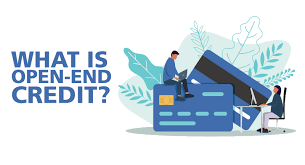Open-end credit, also known as revolving credit, offers financial flexibility and convenience for borrowers. It allows users to borrow up to a pre-approved credit limit, repay their balance, and borrow again without needing to reapply. Unlike closed-end credit (such as loans with fixed terms and repayment schedules), open-end credit provides a continuous borrowing option with no set end date. Understanding this type of credit and its practical applications is important for consumers, credit users, and finance students.
Here, we’ll explore what open-end credit is, how it works, and provide clear examples to help you grasp the concept better.
What Is Open-End Credit?
Open-end credit gives consumers access to funds repeatedly up to a certain credit limit. When borrowers repay part of their borrowed money, their available credit limit is replenished. This type of credit is convenient for both personal and business use, as it provides ongoing access to funds.
Some key features of open-end credit include:
- No fixed repayment schedule (though minimum payments are often required)
- Revolving credit limits that reset as you repay borrowed amounts
- Flexibility to use funds for various purposes
- Interest charged only on the amount borrowed (not the full credit limit)
Examples of Open-End Credit
The following are common examples of open-end credit:
1. Credit Cards
Credit cards are the most widely recognized form of open-end credit. Here’s how it works:
- A credit card issuer sets a credit limit based on your financial profile (income, credit score, etc.).
- For example, if your credit limit is $5,000 and you spend $1,500 in a month, your remaining credit would be $3,500.
- Once you repay the $1,500, your available credit returns to the full $5,000.
- Credit card companies charge interest on any unpaid balance, and you’re required to make at least a minimum payment each month.
Credit cards are incredibly versatile and are used for everyday purchases, travel expenses, and even online shopping. Popular examples include Visa, Mastercard, and American Express cards.
2. Personal Lines of Credit
A personal line of credit functions similarly to a credit card but often operates through a bank account:
- Borrowers receive access to a set credit limit, such as $10,000.
- You can withdraw funds whenever needed, whether it’s for emergencies, home improvements, or unexpected medical expenses.
- Repaying the borrowed amount restores your credit limit, allowing you to borrow again.
Unlike credit cards, many personal lines of credit do not involve using physical cards, and they may offer lower interest rates.
3. Home Equity Lines of Credit (HELOCs)
A HELOC is a specific type of open-end credit secured by the equity in your home. Here’s how it works:
- Homeowners can borrow against the value of their home, minus the outstanding mortgage balance.
- For example, if your home is worth $300,000 and you owe $200,000, your equity is $100,000. A lender may approve a $50,000 HELOC based on this equity.
- Like other forms of open-end credit, you can borrow as needed from this line of credit and repay only the amount used.
- A HELOC is often used for large expenses like remodeling projects or consolidating high-interest debts.
Because HELOCs are secured by your home, they typically offer lower interest rates compared to unsecured forms of open-end credit.
Advantages of Open-End Credit
Open-end credit provides significant benefits for borrowers:
- Flexibility: You can use the credit for a wide range of purposes, from everyday purchases to large, unexpected expenses.
- Pay Interest Only on What You Use: Unlike closed-end loans, you’re only charged interest on the amount borrowed—not the entire credit limit.
- Reusable Credit: Once you repay the amount you borrowed, your credit limit resets, offering ongoing availability.
- Convenience: Credit cards are universally accepted, and lines of credit are easy to access when needed.
Disadvantages of Open-End Credit
Despite its advantages, open-end credit also has potential downsides:
- Overspending Risk: The ease of borrowing can tempt users to overspend, leading to unmanageable debt.
- Variable Interest Rates: Many open-end credit products (like credit cards) have variable interest rates, which may increase over time.
- Impact on Credit Score: High credit utilization (how much of your credit limit you use) can negatively affect your credit score if not managed properly.
Should You Use Open-End Credit?
Open-end credit can be an excellent financial tool if used responsibly. It’s ideal for covering short-term expenses, managing cash flow, or being prepared for emergencies. However, it’s important to stay disciplined to avoid accumulating high-interest debt.
When considering open-end credit, such as a credit card or HELOC, evaluate your financial situation, borrowing needs, and ability to repay timely to maximize the benefits.
Final Thoughts
Examples of open-end credit include credit cards, personal lines of credit, and HELOCs, each offering unique features tailored to different needs. For consumers and business professionals, understanding how to use open-end credit strategically can lead to better financial management and access to funds when needed.
Whether you’re a finance student researching credit types or a consumer exploring borrowing options, recognizing how open-end credit works can empower you to make more informed financial decisions.








